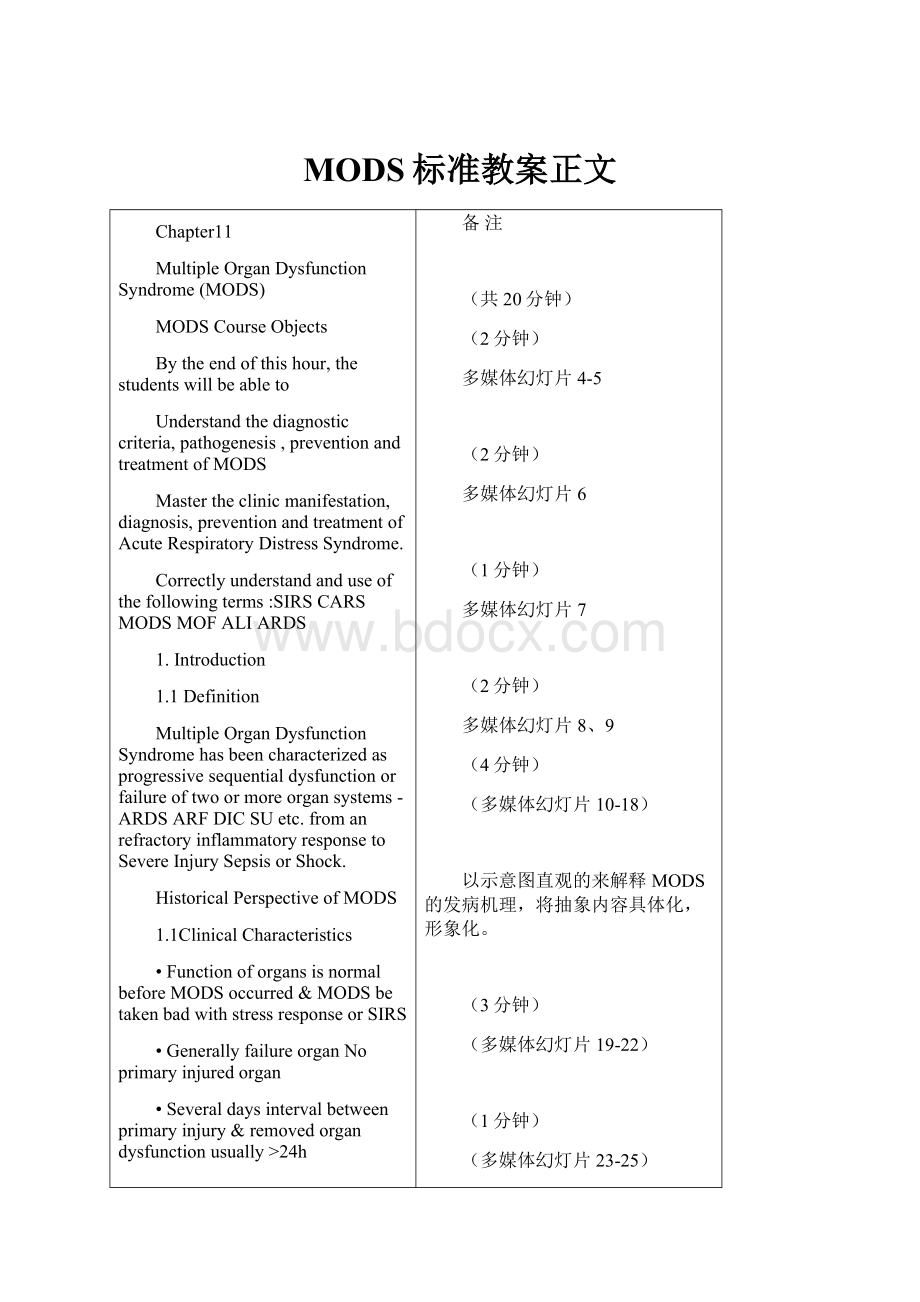MODS标准教案正文.docx
《MODS标准教案正文.docx》由会员分享,可在线阅读,更多相关《MODS标准教案正文.docx(19页珍藏版)》请在冰豆网上搜索。

MODS标准教案正文
Chapter11
MultipleOrganDysfunctionSyndrome(MODS)
MODSCourseObjects
Bytheendofthishour,thestudentswillbeableto
Understandthediagnosticcriteria,pathogenesis,preventionandtreatmentofMODS
Mastertheclinicmanifestation,diagnosis,preventionandtreatmentofAcuteRespiratoryDistressSyndrome.
Correctlyunderstandanduseofthefollowingterms:
SIRSCARSMODSMOFALIARDS
1.Introduction
1.1Definition
MultipleOrganDysfunctionSyndromehasbeencharacterizedasprogressivesequentialdysfunctionorfailureoftwoormoreorgansystems-ARDSARFDICSUetc.fromanrefractoryinflammatoryresponsetoSevereInjurySepsisorShock.
HistoricalPerspectiveofMODS
1.1ClinicalCharacteristics
•FunctionoforgansisnormalbeforeMODSoccurred&MODSbetakenbadwithstressresponseorSIRS
•GenerallyfailureorganNoprimaryinjuredorgan
•Severaldaysintervalbetweenprimaryinjury&removedorgandysfunctionusually>24h
•Thedegreeoforgansdysfunctionisinconsistentwithpathologicdamagedegreeoforgans
•Acuteonset,refractorywithconventionaltreatment(anti-shockanti-infection)&highmortality
•MODSisreversibleexceptterminal400,000$/pt.
1.3RiskFactorsofMODS
•MajorCauses
-Injuries(SeveretraumaBurn&Post-operation)
-Sepsis
-Shock
•PostCardiopulmonaryResucitation(CPR)
•Acutehemorrhagicnecrosispancreatitis
•Miscellaneous
-includeage(>65),malnutrition,Immunologicdisorders,
bloodtransfusionandpreexistingchronicdiseasesuchas
cancerordiabetesetc.
1.4PathophysiologyofMODS
–Injuryorendotoxinrelease
–Vascularendothelialdamage
–Neuroendocrineresponse
–Releaseofinflammatorymediators
–Activationofcomplement,coagulation,kallikrein/kininsystems
–VascularChanges
–Maldistributionofsystemicandorganbloodflow
–Hypermetabolism
–Oxygensupply/demandimbalance
–Tissuehypoxia
–Organdysfunction
1.5PathogenesisofMODS
•UnbalancebetweenSIRSsystemicinflammatoryresponsesyndrome&CARScompenstoryanti-inflammatoryresponsesyndrome.
•Gutbacterialtranslocation
•Ischemia-reperfusioninjury
•Proinflammatorycytokines:
–TNF–alpha
–IL-1,IL–6,IL–8,IL–12
–Interferon–gamma
•Anti-inflammatorycytokines
–IL–4,IL–10,IL–13
–Transforminggrowthfactor(TGF)-beta
1.6MODSDeterminantsafteronset
•Somepatientsrecoverwithoutcomplicationswhileothersdevelopsepticshock
•Cause
–Differenceinthedegreeofinflammatoryresponsetotheinfection
•Tumornecrosisfactor-alpha(TNF-)-principalmediatorofsepticshock
•MortalityandhemodynamicderangementcloselycorrelatedwiththeTNF-level
Bacteriatranslocation
OrganIschemia-reperfusioninjury
1.7SpecificOrganResponsesofMODS
•Heart:
-MIDCardiacDysfunctionorheartfailure
•Lung:
V/QmismatchHypoxemia
–Increasedmicrovascularpermeability
•Interstitial/alveolaredema
–ARDS
•Gastrointestinal/Hepatic:
ImpairedGImotility
•Bacterialtranslocation>>MODS
–Stress-ulcerGIbleeding
–Hepaticdysfunction
•Kidney:
–Alteredrenalfunction
–ATN/acuterenalfailure
•Increasesmortalityrate
•Neurologic:
–Encephalopathy
–Peripheralpolyneuropathy
•68%-100%
•Hematologic:
–Leukocytosis/leukopenia
–Thrombocytopenia
–Coagulopathy
–DIC
•~15%-20%
MODSClinicalcategories
–PrimaryMODS:
earlyorgandysfunction
–SecondaryMODS:
laterorgandysfunction
•MostcommonmanifestationsofsevereMODS:
–ARDS,ARF,DIC,StressUlcer.
1.8MODSDiagnosis
•PrincipaldiagnosticcriterionsofMODS:
•-History
SevereSepsisTraumaShock
Postgreatorcomplexoperation
PostCPR
•-ClinicalmanifestationsofSIRS&CARS
•-Twoormoreorgansystemsdysfunction
SIRSDiagnosis
–Widespreadinflammatoryresponseinabsenceofdocumentedinfection
–Need2ormore:
•Temp>380C(100.40F)or<360C(96.80F)
•Heartrate>90bpm
•Respiratoryrate>20/minorPaCO2<32mmHg
•WBC>12,000cells/mm3,<4,000cells/mm3,or
>10%immature(band)form
MODSEarlyDiagnoses
•EarlyexactlyjudgementtoSIRS&organsystemicdysfunction
•AcquaintancetoRiskFactorsofMODS
•PathogenesisSIRS+organdysfuction
•ClinicalcharacteristicsofMODS
•Thinkmuchoforgandysfunctionthanorganfailure
•Payattentiontohepaticgasro-intestinalhematologicorgansystemicdysfunction
1.9MODSPrevention&Treatment
•CurrenttherapyofMODSisaimedatpreventionandsupportivecare.
•Threegeneralareasare:
-sourcecontrol
-restorationandmaintenanceofoxygentransport
-metabolicsupport.
•Functionalstateoforgansespeciallycirculation&respiration
•Prevent&controlinfection
•Earlymanagementoffirstoutbreakorgandysfunction
•Improvegeneralsituation&maintenanceinternalenvironmentstabilization
•IntensiveGastro-intestinalprotect
•Monitorsystems&organs
•immunotherapy
•Sourcecontrolisamajoremphasis,aspersistenceofasourceguaranteesahighmortalityriskfromMODS.
•MalnutritionisoneoftheprimarymanifestationsofMODS.
2.AcuteRespiratoryDistressSyndromeARDS
2.1ARDSHistoricalPerspectives
OriginalDefinition
•Acuterespiratorydistress
•Cyanosisrefractorytooxygentherapy
•Decreasedlungcompliance
•Diffuseinfiltratesonchestradiograph
•Difficulties:
–lacksspecificcriteria
–controversyoverincidenceandmortality
ARDS1994Consensus
•Acuteonset
–mayfollowcatastrophicevent
•Bilateralinfiltratesonchestradiograph
•PAWP≤18mmHgnoclinicalevidenceofleftheartfailure
•Twocategories:
–AcuteLungInjury-PaO2/FiO2ratio<300
–ARDS-PaO2/FiO2ratio<200
2.2Epidemiology
•Earliernumbersinadequate(vaguedefinition)
•Using1994criteria:
–17.9/100,000foracutelunginjury
–13.5/100,000forARDS
–Currentepidemiologicstudyunderway
•Inchildren:
approximately1%ofallPICUadmissions
2.3ARDSIncitingFactors
•Trauma
•Infections
•Shock&DIC
•ARF
•Acutehemorrhagicnecroticpancreatitis
•Bloodtransfusion
•AspirationofgastriccontentsorInhalationoftoxicgasesandfumes
•Drugsandpoisons
2.3ARDSPathogenesis
•Incitingevent
•Inflammatorymediators
–Damagetomicrovascularendothelium
•Damagetoalveolarepithelium
–Increasedalveolarpermeabilityresultsinalveolaredemafluidaccumulation
•Targetorganinjuryfromhost’sinflammatoryresponseanduncontrolledliberationofinflammatorymediators
•LocalizedmanifestationofSIRS
•Neutrophilsandmacrophagesplaymajorroles
•Complementactivation
•Cytokines:
TNF-a,IL-1b,IL-6
•PlateletactivationfactorPAF
•Eicosanoids:
prostacyclin,leukotrienes,thromboxane
•Freeradicals
•Nitricoxide
2.4ARDSStages
2.4.1Acute,exudativephase
–rapidonsetofrespiratoryfailureaftertrigger
–diffusealveolardamagewithinflammatorycellinfiltration
–hyalinemembraneformation
–capillaryinjury
–protein-richedemafluidinalveoli
–disruptionofalveolarepithelium
•Basementmembranedisruption
–TypeIpneumocytesdestroyed
–TypeIIpneumocytespreserved
•Surfactantdeficiency
–inhibitedbyfibrin
–decreasedtypeIIproduction
•Microatelectasis/alveolarcollapse
2.4.2ARDSProliferativePhase
•ProliferativePhase:
–persistenthypoxemia
–developmentofhypercarbia
–fibrosingalveolitis
–furtherdecreaseinpulmonarycompliance
–pulmonaryhypertension
•TypeIIpneumocyte
–proliferate
–differentiateintoTypeIcells
–relinealveolarwalls
•Fibroblastproliferation
–interstitial/alveolarfibrosis
NORMALALVEOLUS
2.4.3ARDSFibroticPhase
•Characterizedby:
–localfibrosis
–vascularobliteration
•Repairprocess:
–resolutionvsfibrosis
ARDS
2.4.4Recoveryphase
•Recoveryphase
(Recuperative/TerminalPhase)
–gradualresolutionofhypoxemia
–improvedlungcompliance
–resolutionofradiographicabnormalities
2.5ARDSClinicalFeatures
Acutedyspnea/tachypnea
–rales/rhonchi/wheezing
Resistanthypoxemia
–PaO2/FIO2<150–200mmHg
CXR
–diffuse,bilateralinfiltrates
NoevidenceofLVfailure
–(PAWP<18mmHg)
ARDSABNORMALITIESOFGASEXCHANGE
•Hypoxemia:
HALLMARKofARDS
–Increasedcapillarypermeability
–Interstitialandalveolarexudate
–Surfactantdamage
–DecreasedFRC
–Diffusiondefectandrighttoleftshunt
earlydiffusealveolardamage
withhyalinemembranedisease
•Mediumpowersection(40x)lungparenchyma
•Extensivethickeningofalveolarseptum(wall)
•Congestionoflungcapillaries;withendotheliumleakage
•Alveolaredema
•Intenselyeosinophilicnoncellularhyalinemembranematerialinalveolarairspace
ARDS
latediffusealveolardamagewithType-2pneumocytemigration(hi-mag)
•ThebluearrowspointtothetypeIIpneumocyteswhichareveryprominent;theirnucleiprotrudingintothealveolarspace.
•Thearrowshighlightthethickenedseptum(alveolarwall).
•Theseptumcontainsexcesscollagen,fibroblasts,andlymphocytes.
•Hyalinemembranesarenotpresentatthisstage.
2.6ARDSDifferentialDiagnosis
•CARDIOGENICPULMONARYEDEMA
Bronchopneumonia
Hypersensitivitypneumonitis
•Pulmonaryhemorrhage
•Acuteinterstitialpneumonia(Hamman-RichSyndrome)
ARDSMortality
•40-60%
•Deathsdueto:
–multi-organfailure
–sepsis
•Mortalitymaybedecreasinginrecentyears
–betterventilatorystrategies
–earlierdiagnosisandtreatment
2.7ARDSMANAGEMENT
2.7.1Monitoring:
–Respiratory
–Hemodynamic
–Metabolic
–InfectionsShockTraumasepesis(sources)
–Fluids/electrolytes
2.7.2ARDSBasicPrinciplesintheVentilatory
•Accomplisheffectivegasexchange
•Avoidcomplications
–reducedcardiacoutput
–barotrauma
–oxygentoxicity
–ventilator-inducedlu